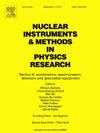通过消除非偏振低散射矢量区来扩大中子光学的偏振带宽
IF 1.5
3区 物理与天体物理
Q3 INSTRUMENTS & INSTRUMENTATION
Nuclear Instruments & Methods in Physics Research Section A-accelerators Spectrometers Detectors and Associated Equipment
Pub Date : 2025-04-25
DOI:10.1016/j.nima.2025.170576
引用次数: 0
摘要
极化中子散射是一种重要的分析技术,在磁学和磁性材料、凝聚态物理、软物质和生物系统等研究领域提供了有价值的信息。增强这些实验依赖于偏振中子光学的性能,以提供各种散射矢量qz的反射率和偏振。目前最先进的Fe/Si超镜偏振器在Si的临界矢量qc以下有一个未偏振的qz区,而具有中子吸收Gd层的FeCoV/TiN超镜可以在较低的角度偏振,但由于中子被吸收而不能在传输模式下工作。为了解决这些挑战,在Ti衬底上使用Co/Ti超镜,因为它们具有良好的散射长度密度特性,并且不使用中子吸收层。这种方法使更高程度的设计灵活性成为可能,例如透射偏振片。对于给定的较低波长限制和光束发散,它允许最低可能的高qz限制(涂层的m值)。本文章由计算机程序翻译,如有差异,请以英文原文为准。
Expanding polarization bandwidth in neutron optics by eliminating the non-polarized low scattering vector region
Polarized neutron scattering is an important analysis technique offering valuable information in research fields such as magnetism and magnetic materials, condensed matter physics, and soft matter and biological systems. Enhancing these experiments relies on the performance of polarizing neutron optics to provide reflectivity and polarization at a variety of scattering vectors qz. State-of-the-art Fe/Si supermirror polarizers have an unpolarized qz-region below the critical vector qc of Si, while FeCoV/TiN supermirrors with a neutron absorbing Gd layer, can polarize at lower angles but cannot operate in transmission mode due to neutron beings absorbed. To address these challenges, the use of Co/Ti supermirrors on Ti substrates is proposed due to their favorable scattering length density characteristics and without using a neutron absorbing layer. This approach enables the possibility of a higher degree of design flexibility for e.g. transmission polarizers. It allows for the lowest possible high-qz limit (the m-value of the coating) for a given lower wavelength limit and beam divergence.
求助全文
通过发布文献求助,成功后即可免费获取论文全文。
去求助
来源期刊
CiteScore
3.20
自引率
21.40%
发文量
787
审稿时长
1 months
期刊介绍:
Section A of Nuclear Instruments and Methods in Physics Research publishes papers on design, manufacturing and performance of scientific instruments with an emphasis on large scale facilities. This includes the development of particle accelerators, ion sources, beam transport systems and target arrangements as well as the use of secondary phenomena such as synchrotron radiation and free electron lasers. It also includes all types of instrumentation for the detection and spectrometry of radiations from high energy processes and nuclear decays, as well as instrumentation for experiments at nuclear reactors. Specialized electronics for nuclear and other types of spectrometry as well as computerization of measurements and control systems in this area also find their place in the A section.
Theoretical as well as experimental papers are accepted.

 求助内容:
求助内容: 应助结果提醒方式:
应助结果提醒方式:


